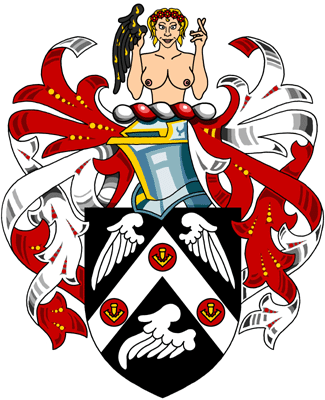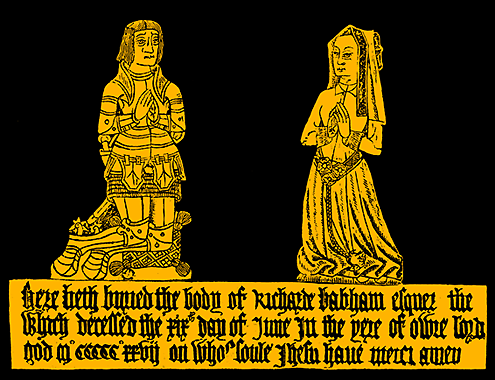 |
 |
|||
|
|
The Babhams were a family of minor Berkshire gentry who took there name from there own estate at Babham End, the area around where the waters of the Lulle Brook and the Thames meet in Cookham. The placename means 'Babba's Home'. Babba is usually said to have been a Saxon chieftain, but it is also a feminine British name. The Babham's house was called Babham Inn (though it was not a public house). The present building is called Formosa Place. The family lived at Babham End from at least the end of the 13th century when William, Alexander and John de Babham were in residence. Perhaps they were brothers. The first of the Babhams from whom the later generations definitely claimed descent was a certain John Babham who was active in the reign of King Henry VI. He apparently received the grant of his Cookham estate on the feast of St. Thomas in 1448. Little else is known of him but, after his death, a good memorial brass was erected to his memory in Cookham Church. His figure in civilian dress survives, but his wife, Muriel, is now missing. John's relation with the next generation of Babhams is unknown, but it seems likely that they were his sons. A Richard Babham of Cookham died in 1483. One of his executors was Thomas Babham, a London grocer whose mercantile activities must have made him a rich man. He also made his way at court, being both Groom of the Robes and, appropriately, Garbler of Spices. He was also a Commissioner of Swan-Mote on the Thames. Thomas had a large family of at least eight children. They probably had descendants in London. His second son, Richard, extended his grocery interests to the more specialised commodities of sweetmeats, and then herbs and medicines. He briefly worked for King Henry VII and so attended his funeral. By 1516, he was serving as Sergeant of the Confectionary, supervising the iced deserts at Henry VIII's Coronation Feast: an event at which he apparently wore scarlet and red. Shortly afterwards, he was appointed the King's Apothecary, upon the retirement of Thomas Pierson. He was paid £10 a year and is recorded as having supplied the King with numerous spices as well as 'gilt lozenges'. Richard had to attend King Henry at many public events such as the famous meeting with King Francis I of France at the Field of the Cloth of Gold. Richard died in June 1527 and was buried in Cookham Church under another good brass near that of his presumed grandfather. He is depicted kneeling in armour with his wife of unknown name, but no children (see picture below - unfortunately his upper body is now missing). The family continued at Babham End with a John Babham and his son, another John. The former may have been a son of Richard Babham who died in 1483. Although the latter's family home was in Cookham and he owned the manor of Aston Clinton in Buckinghamshire, he must have spent much of his time on the estates of his employer, the Countess of Salisbury. This lady was the last of the Plantagenets, a niece of King Edward IV, and therefore a threat to Henry VIII's position as King of England. It may have been at her Berkshire manor of Bisham that John first came into her employ. He rose to be the steward of her household and must have witnessed some extraordinary scenes as the lady and her family fell from Royal favour. The Countess' son, Reginald Pole, was a prominent churchman and staunch Catholic. From a self-imposed exile on the Continent, he refused to support the King's divorce and was pronounced a traitor. He had contact with his brother, Geoffrey, through a boatman named Hugh Holland from Warblington in Hampshire where the Countess had her main country residence, Warblington Castle. John Babham is recorded as having confronted Holland and warned him to keep his Continental sojourns a secret or he might lose his life. In the end this fate befell, not Holland, but the Countess and her eldest son. Babham had to find employment elsewhere, though he was already of considerable standing locally and was a Justice of the Peace in Buckinghamshire.
Either of the younger Christopher Babhams may have been the man who was resident in London by 1630. With the family estate sold, both would have had money to spent. This man rented a gunner's room at the Tower and invested heavily in the Salisbury Court Private Theatre. However no previous theatrical connection for him is known. He bought out Richard Gunnell to become a partner with William Blagrave, the Deputy Master of the Revels. The latter may have been one of the Blagraves from Shrivenham, so the two could have known each other through some Berkshire connection. The deal was not successful and years of legal wrangling ensued. Later, Christopher became involved in the Blackfriars Theatre and even poached, Stephen Hammerton, a young actor from his would-be partner.
|
|||
| © Nash Ford Publishing 2010. All Rights Reserved. | ||||



 The
Babham Family
The
Babham Family John
Babham had four sons, two of whom headed up family branches: Arthur at
Babham End and Henry at Weston Turville in Buckinghamshire. the latter's
descendants carried on in that county for some time. Arthur Babham has a
fine wall monument in Cookham Church, showing himself, his wife and his
seven children. The eldest son, John, had a son, Christopher, in Cookham and
so did his younger brother, another Christopher. This elder Christopher
seems to have either inherited or purchased Babham End from his brother. He
sold up to John Harrison in 1612. Harrison may have been a relative of
Christopher Babham's wife, Elizabeth, the sister of the first
John
Babham had four sons, two of whom headed up family branches: Arthur at
Babham End and Henry at Weston Turville in Buckinghamshire. the latter's
descendants carried on in that county for some time. Arthur Babham has a
fine wall monument in Cookham Church, showing himself, his wife and his
seven children. The eldest son, John, had a son, Christopher, in Cookham and
so did his younger brother, another Christopher. This elder Christopher
seems to have either inherited or purchased Babham End from his brother. He
sold up to John Harrison in 1612. Harrison may have been a relative of
Christopher Babham's wife, Elizabeth, the sister of the first